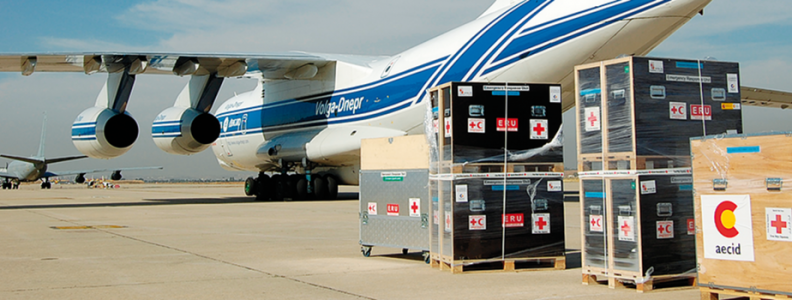
Ship Shape For The Future
Ethiopian Airlines has transformed itself into an aviation group consisting of seven different profit units- ET International, ET Domestic, ET Cargo, ET Aviation Academy, ET Catering, ET Ground Handling and ET MRO. The move, which took place on October 1, was in line with the company’s Vision 2025,a 15-year development strategy that it launched in 2010. Although the first cargo charter operation was launched to Nairobi in 1946, it was the boom in agricultural products being exported from Ethiopia to Europe starting in the early 1970s that has driven growth in Ethiopians cargo services.
In addition to utilizing the belly space of the Boeing 767-300,757-200,777-200LR, and 737-700/800 passenger fleet aircraft. Ethiopians cargo services include dedicated freighter aircraft operating on both a chartered and scheduled basis. According to Ethiopian Cargo, outgoing goods from Addis Ababa typically consist of frozen meat, fruits, semi-processed (finished) leather, vegetables, flowers, carpets, rugs, chilled meat and frozen fish products. Incoming cargo includes chemicals, equipment and machinery, spare parts, electronics, garments, medicines and tea.
Ethiopian Cargo has a history as long as the airlines passenger services. According to the company, the cargo division now contributes 15% of total group revenue. Ethiopian Cargo adopted its first ever five-year strategic plan in 2008.The introduction of this ‘road map’ has helped identify cargo services as a major and strategic business unit of the airline group. It has included a multimillion dollar infrastructure expansion programme, including the phasing-in of six wide-body dedicated freighter aircraft and construction of a state-of-the-art cargo terminal. This has enabled the cargo business to flourish and achieve record growth rate of more than 25% per annum during the past few years. Following these results, a new 15-year cargo strategy was launched to harness growth opportunities in Ethiopia, Africa and across the globe.
Ethiopian Cargo has been established as a fully fledged profit centre with the vision to be the most competitive African cargo airline by providing safe, market-driven and customer-focused cargo, courier and mail transport services by 2025. The scheduled and charter operations serve points in Europe, Africa and the Middle East ,mainly to export flowers, fruit and vegetables ,and chilled meat. Services to India, Hong Kong and China carry low-volume goods, such as leather products. Currently ,after phasing out two Boeing 747 freighters, Ethiopian Cargo operates six dedicated freighters-two Boeing 757-200Fs,two MD11Fs and two 777-200Fs .
It will soon replace the 757s and MD-11s with 777-200LRFs .Orders have been placed for four 777-200Fs for delivery in 2014 and 2015 .By the end of Vision 2025 ,Ethiopian Cargo will have 11 B777-LRFs ( six owned and five leased) ,four B767Fs ( two owned and two leased ) and three B737SFs. The company said fleet acquisitions so far had helped it take advantage of performance efficiency and cater for the increase in demand, especially for northbound horticultural and similar products to the new markets in Asia and Eastern Europe.
Ethiopian Airlines’ CEO, Tewolde Gebremariam, claimed his company is the largest cargo operator in Africa and among the top 50 in the world. He said it currently operates to 24 destinations and annually carries around 200,000 tons of cargo. Over the past few years, Ethiopian has seen a huge upsurge in its cargo operations, thanks largely to the growth of exports. “In 2005-06, our cargo revenue was just 610 million birr ($ 30 million)In 2012 -13, it was close to 6 billion birr, a tenfold increase. Ethiopian exports mainly perishable products such as flowers, vegetables and meat, which are carried by air, by and large by Ethiopian Cargo,” he said. Tewolde added that, although the cargo business was difficult in the current context of slow global economic growth, persistently high fuel prices, and unbalanced directional flows, the economic growth of Africa in general- and Ethiopia in particular-gave his company great confidence about the future prospects. Africa-Europe and Europe-Africa cargo business is expected to grow between 6-6% per annum over the next years.
Owing to the growing economic and trade ties between Africa and Asia, robust air cargo growth is also forecast between the two regions. “Our cargo business has strong competitive advantages, such as recognized brand in Africa, strategic location, low unit costs, economies of deployment of latest technology, growing exportable products in a northbound direction, and synergistic advantages with cross-utilization of resources with our other businesses,” Tewolde said.
He continued: “We are now into the fourth year of our Vision 2025 Ethiopian Cargo strategic road map and are meeting all our targets. In line with our road map, we have recently established our cargo business as a fully fledged profit centre of the Ethiopian Airline Group, with the aim of a fully tapping into the fast-growing air freight business between Africa and the rest of the world.”
The airline has also started to implement a multiple cargo-hub strategy with West African partner airline Asky, by deploying a Boeing 737-400 freighter which, through its West African hub Lome, is collecting outbound cargo from west and central Africa and feeding Ethiopians global cargo network. Similarly, the airline is distributing in-bound cargo to the entire west and central Africa region through this partnership.
The airline intends to replicate this model in other regions. The airlines Vision 2025 Cargo strategy is based on four pillars-fleet; infrastructure; human resource development; and systems, processes and procedures. The national flag-carrier continues to expand its cargo fleet; two of the four additional Boeing 777Fs will be phased-in- October and November 2014, while the remaining two will arrive in September and October 2015.By 2025, the airline plans to operate close to 20 dedicated freighters to 37 destinations across five continents. Currently, the airline has a cargo terminal with more than 300,000 tones annual capacity.
It recently completed a state-of-the –art cold storage facility with a 65,000 tones annual capacity and it is in the process of building, in two phases, a new cargo terminal with a 1.2 million tones annual capacity, which will be one of the biggest in the world. Tewolde added:”The third pillar of our strategy is human resource development. We are investing heavily in our aviation academy so that it is able to produce sufficient technical and leadership personnel for our growing cargo business. Over the last three years, we have invested around $55 million into the expansion of our academy, which now has an intake capacity of 1,000 trainees.
” Tewolde said his airline is improving its systems, processes and procedures with the aim of providing the most efficient cargo services to its customers.”We started to implement electronic airway bills (e-AWB) in 2012 and are finalizing preparations to implement e-freight with the expected ratification by Ethiopia of the 1999 Montreal Convention… and [we] are working to achieve cargo 2000 (C2k) certification by 2015.
” IATA has said that Ethiopian is taking the lead in Africa by introducing the e-freight business, and that the Ethiopian cargo market is the fourth fastest growing in the world. The national flag-carrier plans to carry 820,000 tons annually and to generate $2 billion from the cargo business by 2025.
Air cargo flights is growing very fast in Ethiopia as the national flag-carrier Ethiopian airlines has set targets and strategies to be met in 15 year plan established in 2010 to be realized in 2025.Among them is to create Addis Ababa as a hub for air cargo and freight from Africa to Europe and from Europe to Africa. They are modernizing their fleet to include eleven B777Fs, four B767Fs and three B737SFs dedicated for charter and scheduled air cargo and freight only.
They are also using Lome airport as the hub for cargo from Central and West Africa to their Addis Ababa hub for global cargo. They are investing in human resource development, systems, processes and procedures to be able to realize their Vision 2025. Anthony A Juma is the Editor and Director Commercial and Flights Operations at Wings Over Africa Aviation Limited.



